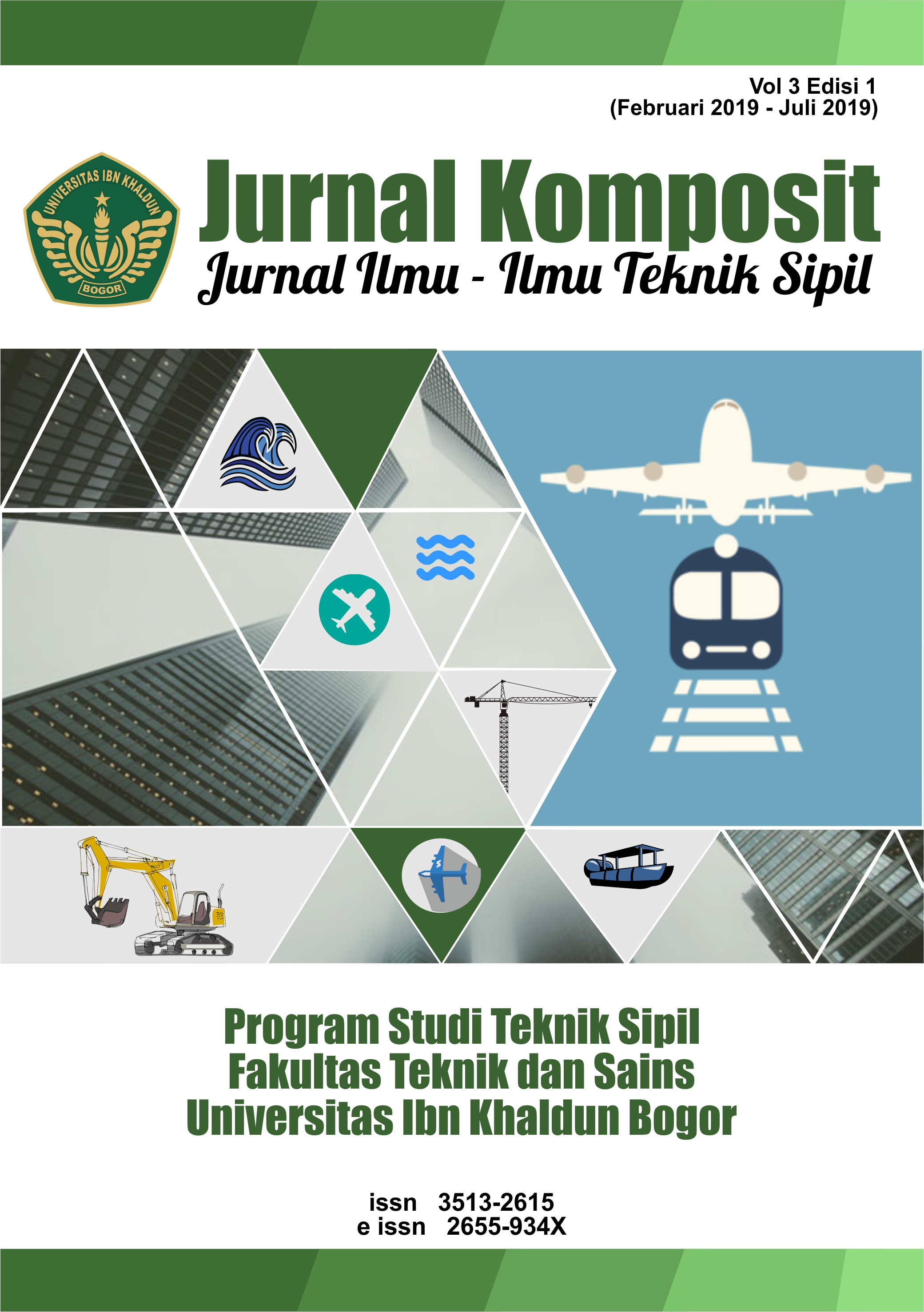STUDI PENGARUH TEMPERATUR BETON MASSA PADA RAFT FOUNDATION KETEBALAN 3 METER (Studi Kasus: Proyek MCC Tower - Jakarta)
DOI:
https://doi.org/10.32832/komposit.v3i1.3743Abstract
Abstrak: Pelaksanaan pekerjaan raft foundation pada proyek MCC Tower, Jakarta dengan ketebalan 3 meter, dengan volume 11.115 m³ yang sangatlah masif. Proses hidrasi semen yang terjadi pada beton massa mengakibatkan beton mengalami peningkatan temperatur yang bervariatif. Pemantauan suhu beton massa perlu dilakukan karena bila tidak dilakukan secara benar, maka dapat terjadi kerusakan berupa retak thermal pada beton massa tersebut, oleh karena itu perawatan beton massa ini sangat diperlukan. Perawatan beton massa yang digunakan dengan cara metode insulasi yaitu dengan curring concrete dan pemasangan styrofoam dengan lembaran plastik. Tujuan yang akan dicapai dari penelitian ini adalah untuk memperoleh analisis temperatur pada beton massa (raft foundation) dengan ketebalan 3 meter sesuai Standard ACI 207.1R-96 tentang Mass Concrete. Penelitian ini dilaksanakan dengan pengumpulan data menggunakan metode interview, observasi, dan dokumentasi. Berdasarkan hasil penelitian menunjukan adanya pengaruh ketebalan beton massa dengan volume beton massa raft foundation. Dari pengamatan suhu yang telah dilakukan, terjadi kenaikan suhu rata - rata pada hari ke-1 sampai hari ke-3 sebesar 52,92 °C. untuk menanggulangi terjadinya perbedaan temperatur yang terus naik maka dilakukan sistem buka tutup lapisan insulasi. Penurunan suhu beton terjadi pada hari ke-6 sampai hari ke-7 yaitu sebesar 11,38 °C. Berdasarkan hasil perhitungan dan analisis dengan metode ACI dan USBR, beton massa tidak mengalami retak termal, serta telah memenuhi syarat yang sesuai standard ACI 207.1R-96 dimana perbedaan nilai antar lapisan atas, tengah, bawah tidak lebih dari 20 °C.Kata Kunci: beton massa, perbedaan temperatur, retak thermal, metode insulasi.
Abstract: Construction of raft foundation work on the MCC Tower project, Jakarta with a thickness of 3 meters, with a very large and massive volume (± 11.115 m³). The cement hydration process that occurs in mass concrete causes the concrete to experience a varied temperature increase. Monitoring the temperature of the mass concrete needs to be done because if it is not done correctly, damage can occur in the form of thermal cracks in the mass concrete, therefore this mass concrete treatment is very necessary. The mass concrete treatment used is the insulation method, namely curring concrete and styrofoam installation with plastic sheets. The purpose of this research is to obtain a temperature analysis of mass concrete (raft foundation) with a thickness of 3 meters according to the ACI 207.1R-96 Standard on Mass Concrete. This research was conducted by collecting data using interview, observation, and documentation methods. Based on the results of the study, there was an effect of mass concrete thickness with the mass concrete volume of raft foundation. From the temperature observations, there is an increase in the average temperature on day 1 to day 3 of 52.92 °C. In order to cope with the increasing temperature difference, an insulation layer is opened and closed repeatedly. The decrease in concrete temperature occurred on the 6th to 7th day, which was 11.38 °C. Based on the results of calculations and analysis using the ACI and USBR methods, the mass concrete of raft foundation does not experience thermal cracks, and has met the requirements according to the ACI 207.1R-96 standard where the difference in values between the top, middle, and bottom layers is not more than 20 °C.
Key words: Mass concrete, temperature difference, thermal cracks, insulation methods.
References
DAFTAR PUSTAKA
American Concrete Institute (2001). Controlling of Cracking in Concrete Structures. ACI 224R 94(3): 11-46.
American Concrete Institute (1996). Mass Concrete. ACI 207.1R : 6-42.
Gajda, J., Vengeem, M. (2002). Controlling temperatur In Mass Concrete. Concrete International. Vol 24 (1). pp. 58 – 62.
A.M Neville. (1981) Properties of Concrete. 3rd Edition. London: Pitman Publising Limited.
Townsend, C.L. (1981). Control of Cracking In Mass Concrete Structures. Washington D.C: U.S Departement of The Interior.
Bartojay, K (2012). Thermal Properties of Reinforced Structural Mass Concrete. Reclamation, Managing Water in the West. Denver: US. Bureau of Reclamation.
Marsiano. (2010). Studi Pembuatan Beton Massa dan Pengaruhnya Terhadap Temperatur (Studi kasus: Project Senopati Suites). Skripsi, tidak diterbitkan. Jakarta: Fakutas Teknik ISTN.
Suryawijaya, M. (2012). Studi Pengaruh Temperatur Beton Massa Pada Kedalaman 4 Meter. (Studi kasus: Raft Foundation Rasuna Tower). Skripsi, tidak diterbitkan. Depok: Fakultas Teknik Universitas Indonesia.
Downloads
Published
How to Cite
Issue
Section
License
Authors who publish with this journal agree to the following terms (Penulis yang mengajukan publikasi artikel telah menyetujui hal berikut):
- Through this publication, the author agree to submit the copyright of article writing to Jurnal Komposit: Jurnal Ilmu-ilmu Teknik Sipil. This copyright submission takes the form of, but is not limited to: reproduction of the article and parts therein, including photographic reproductions; distribution of articles through printed and electronic documents; and translation of articles(Bahwa melalui publikasi ini, hak cipta penulisan artikel diserahkan kepada Jurnal Komposit: Jurnal Ilmu-ilmu Teknik Sipil. Penyerahan hak cipta ini berupa, namun tidak terbatas pada: perbanyakan artikel dan bagian di dalamnya, termasuk reproduksi fotografi; penyebarluasan artikel melalui dokumen cetak dan elektronik; serta penterjemahan artikel).
- The authors agree to the terms of the Copyright Notice, according to Creative Commons Attribution-NonCommercial-ShareAlike 4.0 International License., which will apply to this article if and when it is published by Jurnal Komposit: Jurnal Ilmu-ilmu Teknik Sipil. (Para penulis setuju dengan ketentuan Pemberitahuan Hak Cipta, sesuai dengan Lisensi Internasional Creative Commons Attribution-NonCommercial-ShareAlike 4.0., yang akan berlaku untuk artikel ini jika dan ketika diterbitkan oleh Jurnal Komposit: Jurnal Ilmu-ilmu Teknik Sipil).

This work is licensed under a Creative Commons Attribution-NonCommercial-ShareAlike 4.0 International License.



.png)










